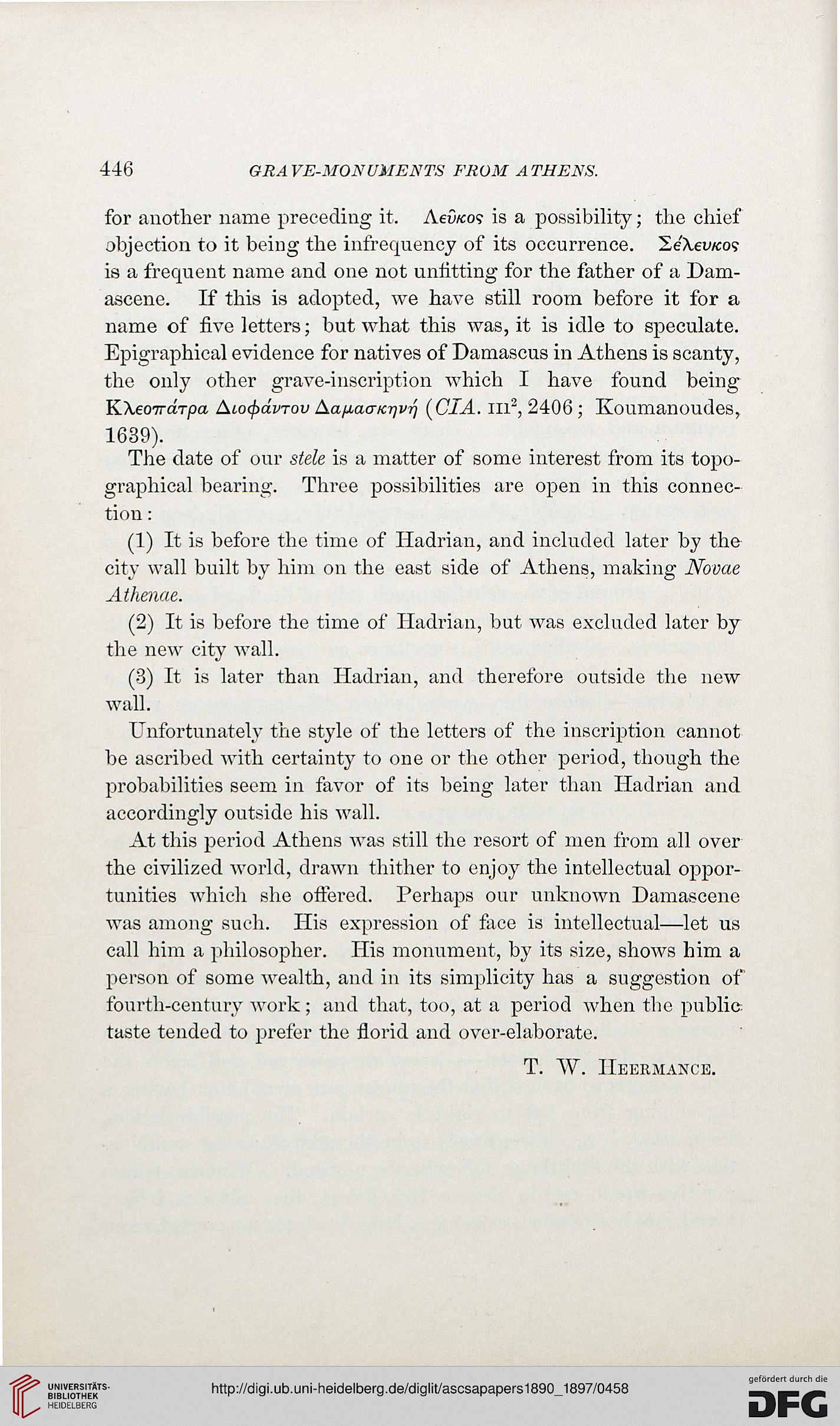446
GRAVE-MONUilESTS FROM ATHENS.
for another name preceding it. AeD/to? is a possibility; the chief
objection to it being the infrequency of its occurrence. 2e'\ewco?
is a frequent name and one not unfitting for the father of a Dam-
ascene. If this is adopted, we have still room before it for a
name of five letters; but what this was, it is idle to speculate.
Epigraphical evidence for natives of Damascus in Athens is scanty,
the only other grave-inscription which I have found being
YLXeoirdrpa Aiocf>dvTov Aa/xaaKrjv^ (CIA. in2, 2406 ; Koumanoudes,
1639).
The date of our stele is a matter of some interest from its topo-
graphical bearing. Three possibilities are open in this connec-
tion :
(1) It is before the time of Hadrian, and included later by the
city wall built by him on the east side of Athens, making Novae
Athenae.
(2) It is before the time of Hadrian, but was excluded later by
the new city wall.
(3) It is later than Hadrian, and therefore outside the new
wall.
Unfortunately the style of the letters of the inscription cannot
be ascribed with certainty to one or the other period, though the
probabilities seem in favor of its being later than Hadrian and
accordingly outside his wall.
At this period Athens was still the resort of men from all over
the civilized world, drawn thither to enjoy the intellectual oppor-
tunities which she offered. Perhaps our unknown Damascene
was among such. His expression of face is intellectual—let us
call him a philosopher. His monument, by its size, shows him a
person of some wealth, and in its simplicity has a suggestion of
fourth-century work ; and that, too, at a period when the public
taste tended to prefer the florid and over-elaborate.
T. TV". Heermancb.
GRAVE-MONUilESTS FROM ATHENS.
for another name preceding it. AeD/to? is a possibility; the chief
objection to it being the infrequency of its occurrence. 2e'\ewco?
is a frequent name and one not unfitting for the father of a Dam-
ascene. If this is adopted, we have still room before it for a
name of five letters; but what this was, it is idle to speculate.
Epigraphical evidence for natives of Damascus in Athens is scanty,
the only other grave-inscription which I have found being
YLXeoirdrpa Aiocf>dvTov Aa/xaaKrjv^ (CIA. in2, 2406 ; Koumanoudes,
1639).
The date of our stele is a matter of some interest from its topo-
graphical bearing. Three possibilities are open in this connec-
tion :
(1) It is before the time of Hadrian, and included later by the
city wall built by him on the east side of Athens, making Novae
Athenae.
(2) It is before the time of Hadrian, but was excluded later by
the new city wall.
(3) It is later than Hadrian, and therefore outside the new
wall.
Unfortunately the style of the letters of the inscription cannot
be ascribed with certainty to one or the other period, though the
probabilities seem in favor of its being later than Hadrian and
accordingly outside his wall.
At this period Athens was still the resort of men from all over
the civilized world, drawn thither to enjoy the intellectual oppor-
tunities which she offered. Perhaps our unknown Damascene
was among such. His expression of face is intellectual—let us
call him a philosopher. His monument, by its size, shows him a
person of some wealth, and in its simplicity has a suggestion of
fourth-century work ; and that, too, at a period when the public
taste tended to prefer the florid and over-elaborate.
T. TV". Heermancb.




